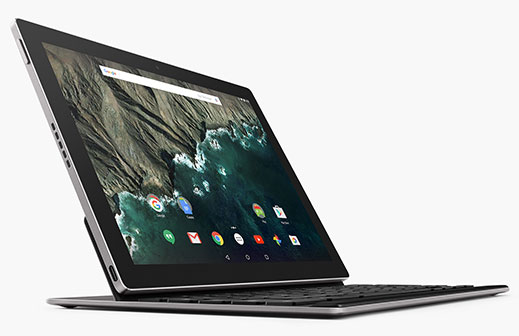Like Microsoft, Google Wants to Sell You a Tablet with a Detachable Keyboard
Tablet computers can be great for watching movies and looking at photos, but chances are you turn to a laptop when you’re trying to get work done—especially if that work involves typing more than a few sentences. If Google gets its way, though, this will change soon.

On Tuesday, the company announced a new tablet that can be purchased with a Bluetooth keyboard that clamps to it with magnets, letting you prop it up like a laptop without actually having to carry a laptop around. Called the Pixel C (the C stands for “convertible”), the gadget runs the latest version of the Android operating system, Marshmallow, and will be released in time for the holidays, Google said. A Pixel C will cost $499 with 32 gigabytes of storage space or $599 with 64 gigabytes, and the attachable keyboard will run another $149.
Google is far from the first company to try to convince consumers to buy into the combination of a tablet and Bluetooth keyboard; Microsoft rolled out the concept with its Surface tablet in the form of a companion keyboard case that’s sold separately, and there are plenty of keyboards available as accessories for existing iPads and Android tablets. Apple will offer a similar option with its forthcoming iPad Pro (the keyboard, like Google’s, will also be sold separately).
Yet so far, no company has really succeeded on a mass scale, and tablet sales have been slowing. Technology market researcher IDC predicts that tablet shipments will fall 8 percent this year, to 212 million. Still, Google is betting that its attention to design and the popularity of the Android software will help it stand apart, and though tablets with detachable keyboards are still a tiny segment of the market, sales are on the rise: IDC predicts these will climb nearly 87 percent this year, with 14.7 million of them being shipped.
The Pixel C itself is unobtrusive, with a 10.2-inch display, three gigabytes of built-in memory, and a weight of about a pound (together with the keyboard, it will weigh a bit under two pounds). It includes four microphones so you can use Google’s voice search and other voice-activated services from across a room, and there are stereo speakers on each side. It also has a USB Type-C port for speedy charging; its battery is meant to last about 10 hours.
When the device is not in use, magnets keep the tablet lying flat atop the keyboard, making it look like a closed, skinny laptop (this is also how the keyboard siphons power from the tablet to charge its batteries via induction). The tablet knows when it’s attached to the keyboard; when it’s not, it will pull up a virtual keyboard for you to type on.
I tried the combination briefly during a media event Google held in San Francisco on Tuesday to introduce the tablet, along with new smartphones and Chromecast streaming devices. I was both impressed by the strength of the magnets—you can hold the keyboard upside down with the tablet attached, and it won’t fall off—and concerned they were so strong that I might end up flinging the tablet across the room while trying to detach it.
Google said the keyboard is full-size, but while I could certainly type on it, it felt noticeably cramped—a sentiment I quickly typed out on a new document I had opened on the display.
With the keyboard connected to the tablet and the tablet’s home screen on the display, typing automatically filled in a query in a Google search box in the center of the screen, which was convenient. But I got the sense I wouldn’t want to type up an entire article on it.
Keep Reading
Most Popular
Large language models can do jaw-dropping things. But nobody knows exactly why.
And that's a problem. Figuring it out is one of the biggest scientific puzzles of our time and a crucial step towards controlling more powerful future models.
How scientists traced a mysterious covid case back to six toilets
When wastewater surveillance turns into a hunt for a single infected individual, the ethics get tricky.
The problem with plug-in hybrids? Their drivers.
Plug-in hybrids are often sold as a transition to EVs, but new data from Europe shows we’re still underestimating the emissions they produce.
Stay connected
Get the latest updates from
MIT Technology Review
Discover special offers, top stories, upcoming events, and more.